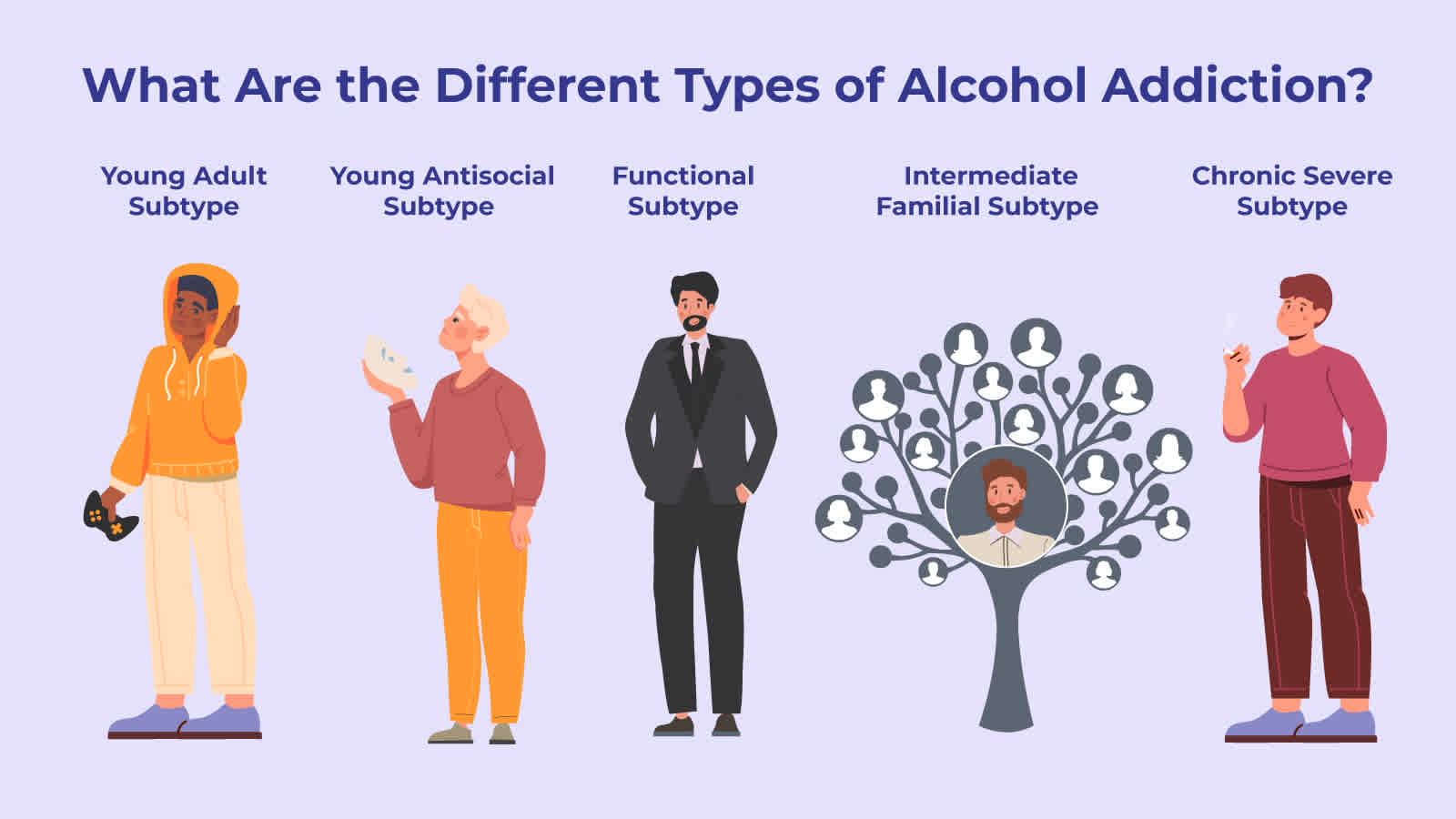Learn / What Are the Different Types of Alcohol Addiction?
What Are the Different Types of Alcohol Addiction?


July 31st, 2023| Clinically Reviewed by
In This Article
Alcohol addiction looks different for different people. Your age, family history, and other mental health issues have a major impact on your drinking habits. To better understand this behavior, experts have defined a few subtypes of drinkers.
About the Subtypes of Alcohol Addiction
Alcohol is legal, accessible, and socially acceptable. Because of this, alcohol addiction is extremely common. According to one survey, 10% of teen and adult Americans have alcohol addiction.1 And you might not realize you have this condition until it gets out of hand. The National Institute on Alcohol Abuse and Alcoholism (NIAA) defines various drinking levels2 as follows:
- Moderate drinking includes up to 2 drinks a day for men, or up to 1 drink a day for women.
- Binge drinking raises your blood alcohol concentration to .008% or higher. For most men, that means having 5 or more drinks in 2 hours. For most women, it means having 4 or more drinks in the same amount of time.
- Heavy drinking refers to a pattern of behavior. For men, it means having over 4 drinks in a given day or over 14 drinks in a week. For women, it means having 3 or more drinks in a day or over 7 drinks in a week.
On their own, these behaviors aren’t always problematic. You can have an occasional night out and still lead a balanced life. But if you binge drink or drink heavily on a regular basis, you increase your risk of alcohol addiction.
In one 2007 study, NIAA researchers defined 5 distinct subtypes of alcohol addiction.3 While these categories are not official diagnoses, some clinicians use them to aid in addiction treatment. You may or may not fit into any of the subtypes. But if you do, this framework can help you understand the root cause of your addiction. It can also help your care team design a treatment plan. If you have a loved one with alcohol addiction, learning about these subtypes can give you insight into their experience.
Young Adult Subtype
Compared to other age groups, young adults have the highest rates of binge drinking.4 This contributes to their high rates of alcohol addiction. According to the NIAA, 31.5% of people with alcohol addiction5 in the U.S. fit into this subtype.
Social norms play a role in young adults’ drinking6 habits. For example, college students tend to drink more than other young adults of the same age. Experts believe this is because students have fewer responsibilities. If you’re working long hours, married, or raising children, you might not have time to go to parties or drink with friends.
Many young adults recover from alcohol addiction without formal treatment. As you take on more work or family commitments, your priorities will naturally change. It’s not that easy for everyone. But data shows that alcohol addiction treatment is extremely effective for this demographic.
Explore Alcohol Treatment Centers
Young Antisocial Subtype
Alcohol addiction and antisocial personality disorder7 often go hand in hand. If you have these co-occurring disorders, you might need specialized care during recovery.
Antisocial personality disorder, or ASPD,8 is a serious mental health issue. Having a parent with alcohol addiction increases your risk of developing this diagnosis. ASPD makes it hard to empathize with the people around you. This personality disorder can undermine your relationships and your career, and even increase your risk of legal issues.
There’s a great deal of overlap between the symptoms of alcohol addiction and ASPD. For example, impulsivity is both a symptom of ASPD9 and a common trait of people with alcohol addiction. You may often find yourself in high-risk situations, including those where you’re encouraged to drink.
Up to 75% of people with ASPD have alcohol addiction.10 Recovery from either one is a complex process. Experts recommend managing the symptoms of ASPD11 with long-term treatment. This usually includes medication and outpatient therapy. Some of the same methods might help you recover from alcohol addiction.
Functional Subtype
Dr. Howard Moss of the NIAA explains that people in this subtype experience “fewer psychosocial consequences from their alcohol dependence.”12 In other words, while this type of drinking can severely damage your health, it might not noticeably affect your relationships. People with this form of alcohol addiction tend to have a few traits in common:
- Middle-aged or retired adults
- Higher family income
- College education
- More lIkely to be married than other subtypes
If you fit into this classification, recovering from your addiction might not feel urgent. But, Moss emphasizes, you might still “be at significant risk of the biomedical consequences” of heavy drinking. In addiction treatment, your therapist can help you understand the impact your addiction has on the rest of your life.
People with functional alcohol addiction can approach recovery in several ways. Many programs, including 12-Step rehabs, encourage total abstinence. But depending on your physical health, that may or may not be necessary for you. For example, your care team might suggest you moderate your drinking instead of quitting completely. If you decide to go this route, make sure you schedule regular check-ins with your doctor, talk therapist, or another provider. They can help you stay on track throughout your ongoing recovery.
Intermediate Familial Subtype
Data shows that there’s a genetic component to alcohol addiction.13 The intermediate familial subtype14 mostly includes middle-aged people with a family history of this condition. People in this category often have co-occurring disorders, especially depression and bipolar disorder, and develop substance use disorders later in life. One study found that most people within this subtype start drinking as teenagers but don’t show signs of alcohol addiction until their 30s.
Nearly 20% of people in the intermediate familial subtype15 also use cocaine, marijuana, or both. Most also smoke cigarettes. If this is your experience, you might consider attending residential rehab for multiple addictions. While inpatient treatment won’t change your family history, it can give you the coping skills you need to move forward.
Chronic Severe Subtype
While chronic severe alcohol addiction16 accounts for just 9.2% of all alcohol addiction in the U.S., this is the most serious subtype. Most people with this condition start drinking in their teens and show signs of alcohol addiction before the age of 30. They are also at a high risk of several different co-occurring disorders:
- ASPD
- Major depression
- Bipolar disorder
- Anxiety disorders
People in this subtype are also at risk for developing multiple addictions at once:
- Marijuana addiction
- Cocaine addiction
- Opioid addiction
- Nicotine addiction
If you fit into this subtype, it’s extremely likely that 2 or more people in your family also have some form of alcohol addiction.
When you enter recovery for chronic severe alcohol addiction, you might need intensive treatment like medical detox. That’s partly because 88% of patients experience withdrawal symptoms when they try to quit drinking.17 Without proper support, alcohol detox can be life-threatening.18
With the right treatment, you can get through this process safely. And once your body heals, you’ll be able to focus on your long-term emotional recovery.
Connect with a rehab for alcohol addiction to start planning your healing journey.
-
“Alcohol Abuse Statistics [2023]: National + State Data.” NCDAS, https://drugabusestatistics.org/alcohol-abuse-statistics/. Accessed 31 May 2023.
-
Drinking Levels Defined | National Institute on Alcohol Abuse and Alcoholism (NIAAA). https://www.niaaa.nih.gov/alcohol-health/overview-alcohol-consumption/moderate-binge-drinking. Accessed 31 May 2023.
-
“Researchers Identify Alcoholism Subtypes.” National Institutes of Health (NIH), 29 Sept. 2015, https://www.nih.gov/news-events/news-releases/researchers-identify-alcoholism-subtypes.
-
Quigley LA, Marlatt GA. Drinking Among Young Adults: Prevalence, Patterns, and Consequences. Alcohol Health Res World. 1996;20(3):185-191. PMID: 31798173; PMCID: PMC6876515.
-
“Researchers Identify Alcoholism Subtypes.” National Institutes of Health (NIH), 29 Sept. 2015, https://www.nih.gov/news-events/news-releases/researchers-identify-alcoholism-subtypes.
-
Quigley LA, Marlatt GA. Drinking Among Young Adults: Prevalence, Patterns, and Consequences. Alcohol Health Res World. 1996;20(3):185-191. PMID: 31798173; PMCID: PMC6876515.
-
Pandey, Susmita, et al. “<p>Antisocial Personality Disorder Among Patients in Treatment for Alcohol Use Disorder (AUD): Characteristics and Predictors of Early Relapse or Drop-Out</P>.” Substance Abuse and Rehabilitation, vol. 12, Apr. 2021, pp. 11–22. www.dovepress.com, https://doi.org/10.2147/SAR.S296526.
-
Fisher KA, Hany M. Antisocial Personality Disorder. [Updated 2022 Aug 15]. In: StatPearls [Internet]. Treasure Island (FL): StatPearls Publishing; 2023 Jan-. Available from: https://www.ncbi.nlm.nih.gov/books/NBK546673/
-
Helle AC, Watts AL, Trull TJ, Sher KJ. Alcohol Use Disorder and Antisocial and Borderline Personality Disorders. Alcohol Res. 2019 Dec 30;40(1):arcr.v40.1.05. doi: 10.35946/arcr.v40.1.05. PMID: 31886107; PMCID: PMC6927749.
-
Pandey, Susmita, et al. “<p>Antisocial Personality Disorder Among Patients in Treatment for Alcohol Use Disorder (AUD): Characteristics and Predictors of Early Relapse or Drop-Out</P>.” Substance Abuse and Rehabilitation, vol. 12, Apr. 2021, pp. 11–22. www.dovepress.com, https://doi.org/10.2147/SAR.S296526.
-
Fisher KA, Hany M. Antisocial Personality Disorder. [Updated 2022 Aug 15]. In: StatPearls [Internet]. Treasure Island (FL): StatPearls Publishing; 2023 Jan-. Available from: https://www.ncbi.nlm.nih.gov/books/NBK546673/
-
Arehart-Treichel, Joan. “Clinical Features Point to Five Alcoholic Subtypes.” Psychiatric News, vol. 42, no. 18, Sept. 2007, pp. 15–15. DOI.org (Crossref), https://doi.org/10.1176/pn.42.18.0015.
-
Edenberg HJ, Foroud T. Genetics and alcoholism. Nat Rev Gastroenterol Hepatol. 2013 Aug;10(8):487-94. doi: 10.1038/nrgastro.2013.86. Epub 2013 May 28. PMID: 23712313; PMCID: PMC4056340.
-
Moss HB, Chen CM, Yi HY. Subtypes of alcohol dependence in a nationally representative sample. Drug Alcohol Depend. 2007 Dec 1;91(2-3):149-58. doi: 10.1016/j.drugalcdep.2007.05.016. Epub 2007 Jun 26. PMID: 17597309; PMCID: PMC2094392.
-
“Researchers Identify Alcoholism Subtypes.” National Institutes of Health (NIH), 29 Sept. 2015, https://www.nih.gov/news-events/news-releases/researchers-identify-alcoholism-subtypes.
-
Moss HB, Chen CM, Yi HY. Subtypes of alcohol dependence in a nationally representative sample. Drug Alcohol Depend. 2007 Dec 1;91(2-3):149-58. doi: 10.1016/j.drugalcdep.2007.05.016. Epub 2007 Jun 26. PMID: 17597309; PMCID: PMC2094392.
-
Moss HB, Chen CM, Yi HY. Subtypes of alcohol dependence in a nationally representative sample. Drug Alcohol Depend. 2007 Dec 1;91(2-3):149-58. doi: 10.1016/j.drugalcdep.2007.05.016. Epub 2007 Jun 26. PMID: 17597309; PMCID: PMC2094392.
-
Trevisan LA, Boutros N, Petrakis IL, Krystal JH. Complications of alcohol withdrawal: pathophysiological insights. Alcohol Health Res World. 1998;22(1):61-6. PMID: 15706735; PMCID: PMC6761825.
Return to Resource Library
Our Promise
How Is RehabPath Different?
We believe everyone deserves access to accurate, unbiased information about mental health and addiction. That’s why we have a comprehensive set of treatment providers and don't charge for inclusion. Any center that meets our criteria can list for free. We do not and have never accepted fees for referring someone to a particular center. Providers who advertise with us must be verified by our Research Team and we clearly mark their status as advertisers.


















